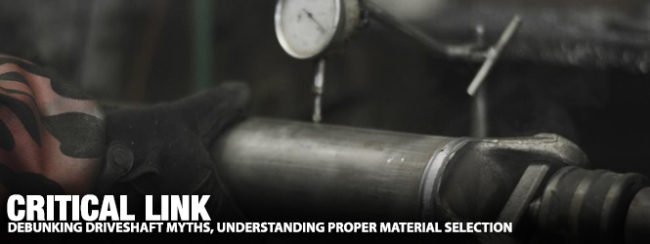
When most people associate a driveshaft as being a simple link between the transmission and rear end. Since so many fail to consider a driveshaft as a performance upgrade, most stray from spending the extra cash on properly selecting the driveshaft to fit their build’s needs. Too often people try to reuse or recut an old OEM driveshaft to keep costs to a minimum. What so many fail to understand is that the driveshaft isn’t just a simple link, it’s the central artery in your car, transferring every inch of torque from your transmission through your driveshaft, to the differential and finally, to the pavement.
After all of the effort in building an 800-horsepower motor, or upgrading to a high stall, manually-shifted transmission believing a stock OEM driveshaft can withhold forces often two or three times stronger than what the factory intended? Popular magazines and websites dedicated to drag and road racing are rife with images of twisted and/or snapped driveshafts, many of which have caused severe injury to both the car and driver. Selecting the right driveshaft and preparing it specifically for your vehicle’s application makes all the difference in the world. We turned to American Powertrain for some insight, as the manufacturer offers a variety of high performance driveshafts for all budgets.

Above: Here is the formula to calculate critical speed for the different materials and tube sizes.
Critical speed is the specific RPM of a driveshaft where it becomes unstable and starts to distort and bend. Pushing a driveshaft past its critical speed will be felt in the form of a severe vibration and could potentially self-destruct or become permanently deformed. Length, tube material, tube diameter and wall thickness all play into critical speed of a drive shaft. When comparing like material, tube size, etc., the longer a driveshaft is, the lower the critical speed becomes.
The critical speed of a longer driveshaft can be raised by increasing its diameter, but there are limits to how big in diameter you can go given exhaust and floor clearances. Below we have included chart showing the critical speeds of the different driveshafts American Powertrain offers. It is great to understand critical speed and thankfully an issue that has already been addressed for most car builder by American Powertrain, who carefully takes your information and provides multiple options that have a critical speed high enough that it wont be a concern.
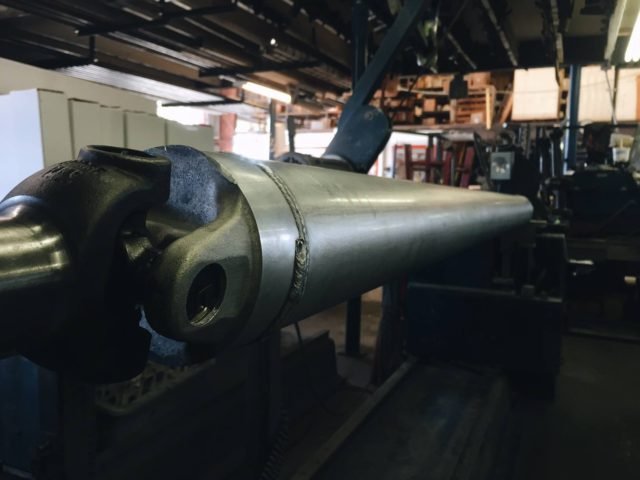
Above: An aluminum driveshaft being prepared to be high speed balanced.
Balancing a driveshaft might sound simple but isn’t always the case. We had a previous driveshaft built at a local shop and after rebalancing and shortening it multiple times due to incorrect measuring and adjustments, we could have bought a carbon shaft with the money spent. Many local drive shaft shops are not equipped nor have the knowledge to address the needs of your custom build, as most factory driveshafts were balanced between 3,000 and 3,500 rpm, and that is what most shops are prepared to handle.
Conversely, a performance driveshaft is recommended to be balanced at a minimum of 5,000 rpm (and as high as 7,500 rpm) to ensure that the driveshaft has been properly balanced to reduce vibration, and whether it efficiently transmits power to the wheels without parasitic loss. These shops high speed balance every driveshaft to insure no vibration when you’re cruising down the freeway or ripping down the track.
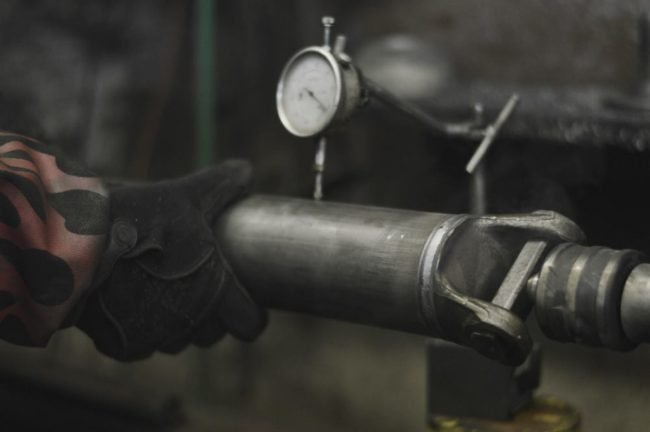
Above: Another aluminum driveshaft being checked for roundness.
Yokes play a big part of transferring the the power through the driveshaft and to the differential. The transmission slip yoke and rear pinion yoke take a lot of abuse. Most yokes are made of cast iron and can normally handle up to 800 horsepower. Of course, the 800hp figure is not an exact number as 800hp street driven Dart is different than 800hp Charger that runs down the strip with drag slicks. The Charger is heavier, the slicks will hook better and create more torsional force on the drivetrain versus the lighter Dart and street tires. You can upgrade to a stronger and lighter chromoly or billet yokes but they may require the use of bigger u-joints and can be costly. Another upgrade when using cast iron yokes is the use of billet u-joint caps over the stock u-bolt style. The billet caps increase holding power and reduce the possibility of distorting the u-joint caps when tightening.
Another issue to be aware of when fitting your driveshaft is the play in the transmission slip yoke. The slip yoke is inserted in the back of the transmission and needs enough room to slide forward when the suspension travels up and briefly shortens the distance between the transmission and differential. If the slip yoke does not have enough play in the transmission it can cause binding, which results in vibration or worst, be catastrophic. On the other hand, it can’t have too much play or when the suspension travels down, lengthening the distance, the yoke might not have enough engagement with the output shaft, and the slip yoke can fall out or wobble, which can also cause vibration or be destructive.
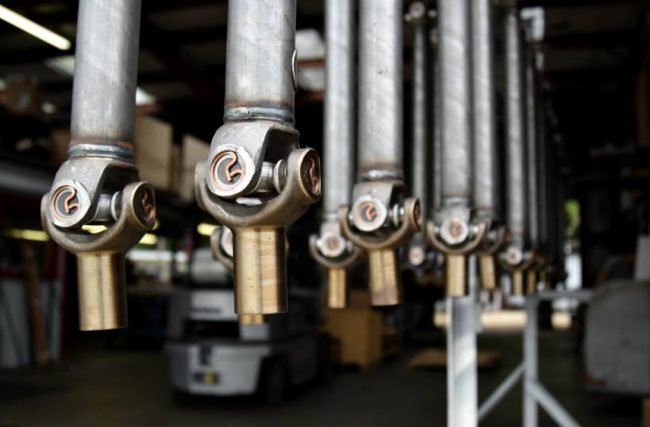
U-joints might be small but they play a critical part in connecting the drive shaft to the rearend and transmission. They have to endure a lot of torsional force (forces exerted in a twisting motion). The majority of V8-equipped Mopars came with a 7260 series u-joint where the Hemi and big block cars that were equipped with Dana 60s or the 489 case-equipped 8.75 differential had a 7290 series u-joint. The larger the series number, the bigger the u-joint and more torsional strength it will have due to the larger diameter trunnion (the protruding shafts the caps ride over). Another common upgrade for Mopar racers is to upgrade their rear yoke to accommodate a 1350 series u-joint because of its bigger size over the 7290 series. Another factor that plays into the strength of the u-joint is whether its greasable or not.
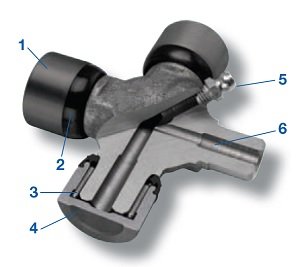
You can see where the u-joint is hollow to allow grease to pass through to each end cap.
Greasable u-joints are argued to last longer and are just as strong as solid u-joints. If you had the same brand greasable and solid u-joints beside each other they appear identical: same size trunnions, same material, etc., which should equate to the same torsional strength, but that’s not true. The greasable u-joint will come drilled for a grease zerk and throughout the u-joint will be pathways machined for the grease to flow through the joint to each end cap.
These openings take away material and creates stress in the material which causes the u-joint to loose strength. The solid u-joint does not have these openings which result in a more uniformed and stronger u-joint. For certain applications, like a tractor, a greasable u-joint is perfectly acceptable but not suggested for high performance applications. American Powertrain does not take any chances and only installs solid u-joints in all of their shafts for their uniformity and strength.
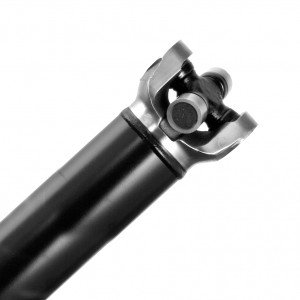
One last type of u-joint to talk about is a crossover u-joint. These u-joints allow smaller or larger u-joint mate to the other. For example if you had a driveshaft for your 8 3/4 that originally took a 7260 joint and later upgraded to the stronger 489 case that requires the use of a 7290 joint, your driveshaft will not change in length but will need the bigger u-joint to mate with the bigger yoke. You can buy a u-joint that will have both 7260 and 7290 ends that will allow you to use your existing driveshaft with the new 489 case. This is a great choice for a temporary or emergency fix but not suggested for long term use because the u-joint is still only as strong as the weakest link which would be the smaller 7260 joint. You would not receive the full benefit of upgrading to the stronger 489 case until you have a new driveshaft built with 7290 u-joints.
Now that we have defined a couple terms, lets talk about driveshaft material choice. Steel, aluminum and carbon fiber are the three most common materials used when building driveshafts. Choosing the right driveshaft material might seem easy but there are multiple factors that fluctuate between each application. We have broken down the basics of each material for a better understanding.
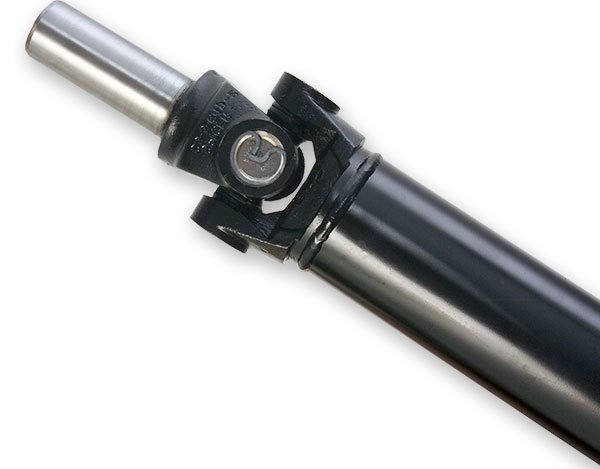
Steel is the most common material used for driveshafts. We see steel used as OEM material for our classic Mopars as well as some modern vehicles. Steel is very durable material that is resistant to twisting. It is also very affordable and makes it a great choice for many applications. We see many drag racers and street driven cars using steel driveshafts with no problems. American Powertrain offers steel driveshafts in 2.5”, 3” and 3.5” tube diameters, which can handle up to 800 horsepower.
There are a few disadvantages with steel driveshafts. Steel is the heaviest material used in making driveshafts, it normally has the lowest critical speed compared to similar aluminum or carbon counter parts. Steel can also rob horsepower from your drivetrain due to the extra effort that is required to rotate the extra weight.
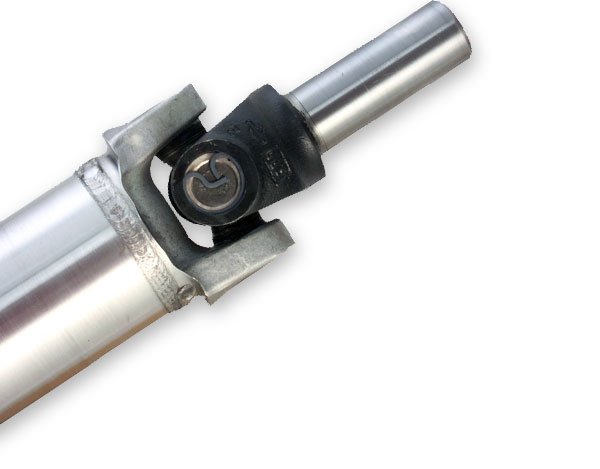
Aluminum is the most common performance driveshaft material and are rated up to 1000 horsepower. In recent years, it has begun to be used as an OEM material in many modern vehicles. As you probably guessed, aluminum is a lot lighter than steel and can free up some horsepower in your engine by reducing parasitic loss. The aluminum driveshaft’s critical speed is higher than a similar sized steel driveshaft. American Powertrain offers 3.5” and 4” diameters with model specific SFI rating and balancing at 1/4 oz./inch on their aluminum driveshafts.
Unfortunately not everything is better with aluminum. The cost of the material is higher than steel and the building process is more difficult, which causes it to be a higher priced option. Aluminum is not as strong as steel, which makes it more susceptible to twisting unless you increase the diameter of the tube. Increasing the tube diameter is not always an option especially with some tight transmission tunnels and stock floor pans.
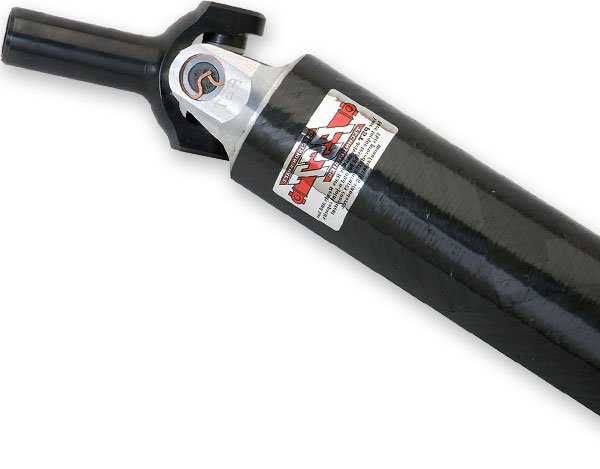
Carbon Fiber driveshafts have recently become more available in the aftermarket world. Just a short time ago you would only find carbon driveshafts in NASCAR or high-end sports cars. As the technology has advanced and the machines became more cost efficient to aftermarket suppliers like American Powertrain, we can now benefit from the benefits of these premier driveshafts. Carbon fiber driveshafts offer the lightest weight, thus freeing up the most horsepower from your drivetrain.
Carbon fiber also offers the highest critical speed, yet still retaining incredible torsional strength. They are SFI rated and balanced at 1/8 oz./inch. American Powertrain’s carbon fiber shafts have been tested and certified at 1700 ft. lbs. of torque. They are offered in smaller diameter at 3.25” and 3.75” versus their counterparts. The biggest downfall you probably guessed, is cost. Compared to steel and aluminum driveshafts, the carbon fiber shafts require a longer building process, complex machinery and high-end materials. If you can swing it, there is no downside to a carbon fiber driveshaft.
Above: We measured from the face of the rear yoke to the back of the transmission housing. You can get a measurement from the transmission with out removing the driveshaft and save you from spilling fluid all over.
Now that your head hurts from this onslaught of information, you can take a deep breath and relax. Although it is great to understand the science behind how and why a certain driveshaft is right for you, American Powertrain will guide you through the havoc of picking out a new driveshaft. Whether you’re looking at replacing that worn out stock driveshaft or have upgraded engine and transmission requiring something stronger, they have a solution for you. To make sure they receive all the required info for your driveshaft, they have conveniently placed a simple order form on their website for you to fill out before you call.
It will require a few specifications about your motor and transmission. You will have to measure the length of your driveshaft but unlike other companies with complex measurements, American Powertrain have simplified this process and only need the measurement from the back of the transmission to the rear yoke. They will calculate in the perfect amount of play in the slip yoke and where the u-joints will need placed. Buying a driveshaft from American Powertrain will ensure ease of installation and no worries about driveshaft vibrations. Let the experts at American Powertrain help you decide which driveshaft is right for your application and order yours today.


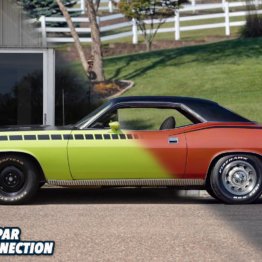
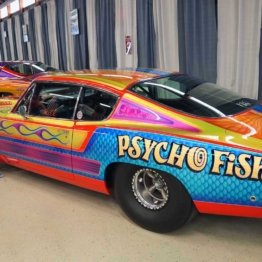
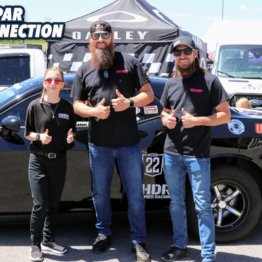

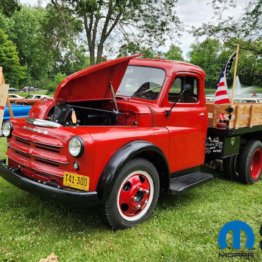
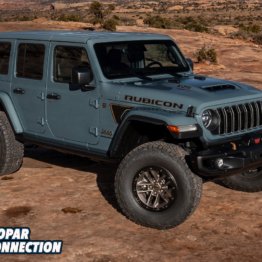

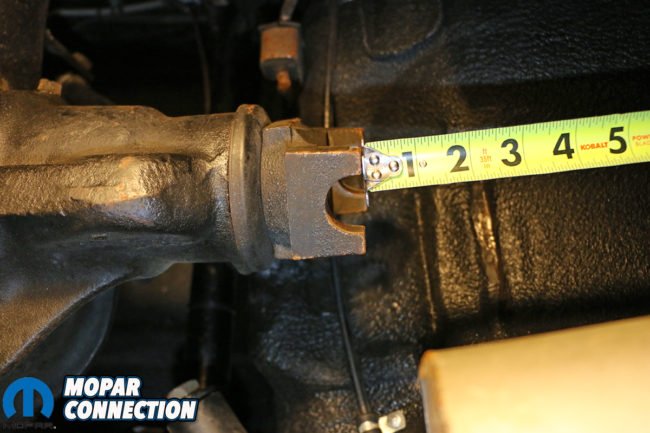
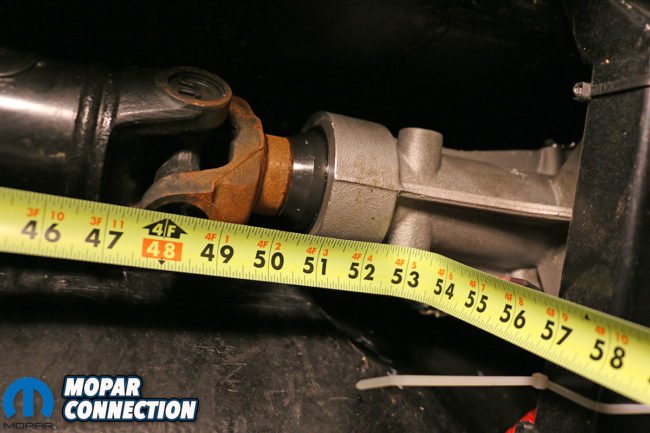

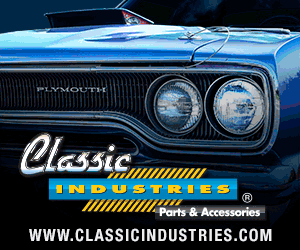
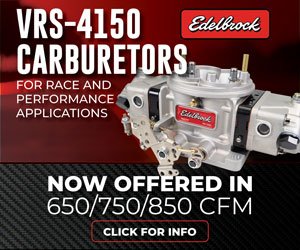
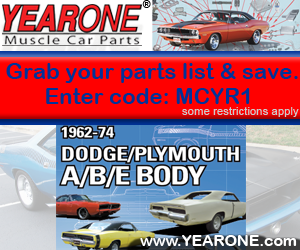
 Mopar Connection Magazine – The ONLY Daily Mopar Magazine © 2022. All Rights Reserved. Mopar Connection Magazine is the ONLY daily Mopar Magazine bringing you the latest Mopar news, technology, breaking news, and Mopar related events and articles. Find out the latest information about Mopar, Mopar products and services, stay up to date on Mopar enthusiast news, dealership information and the latest Mopar social media buzz! Sign up for the Mopar Connection Magazine newsletter for the latest information about new products, services and industry chatter. Mopar Connection Magazine is the best and only source you need to be a Mopar industry insider!
Mopar Connection Magazine – The ONLY Daily Mopar Magazine © 2022. All Rights Reserved. Mopar Connection Magazine is the ONLY daily Mopar Magazine bringing you the latest Mopar news, technology, breaking news, and Mopar related events and articles. Find out the latest information about Mopar, Mopar products and services, stay up to date on Mopar enthusiast news, dealership information and the latest Mopar social media buzz! Sign up for the Mopar Connection Magazine newsletter for the latest information about new products, services and industry chatter. Mopar Connection Magazine is the best and only source you need to be a Mopar industry insider! by
by